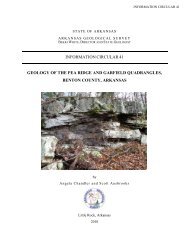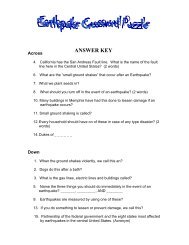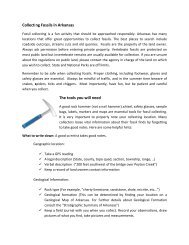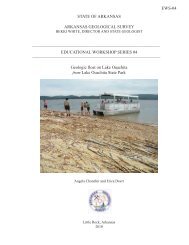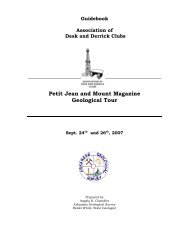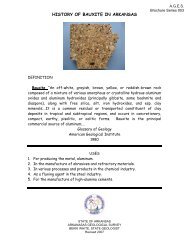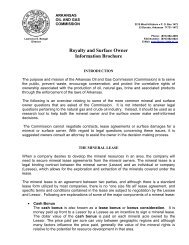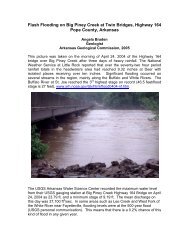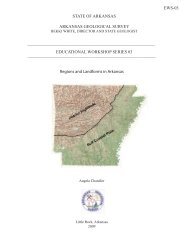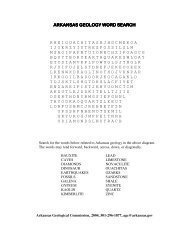Mining, Minerals and More in the Western Ouachita Mountains
Mining, Minerals and More in the Western Ouachita Mountains
Mining, Minerals and More in the Western Ouachita Mountains
- No tags were found...
You also want an ePaper? Increase the reach of your titles
YUMPU automatically turns print PDFs into web optimized ePapers that Google loves.
<strong>Ouachita</strong> Orogeny (Middle Mississippian-Pennsylvanian, 345-299 million years ago)The rocks exposed <strong>in</strong> <strong>the</strong> <strong>Ouachita</strong> Mounta<strong>in</strong>s region are no longer flat-ly<strong>in</strong>g as <strong>the</strong>y wereorig<strong>in</strong>ally deposited. They are steeply <strong>in</strong>cl<strong>in</strong>ed <strong>and</strong> have been folded <strong>in</strong>to anticl<strong>in</strong>es <strong>and</strong>syncl<strong>in</strong>es. Compare <strong>the</strong> attitude of <strong>the</strong> rocks <strong>in</strong> <strong>the</strong> <strong>Ouachita</strong> Mounta<strong>in</strong>s region with those <strong>in</strong> <strong>the</strong>Arkansas River Valley <strong>and</strong> <strong>the</strong> Ozark Plateaus Regions.Figure 8. This figure displays an anticl<strong>in</strong>e that has been distorted due to fold<strong>in</strong>g. Look for <strong>the</strong>se types offolds at each fieldtrip stop.To underst<strong>and</strong> why <strong>the</strong> rocks are no longer flat-ly<strong>in</strong>g we need to look back <strong>in</strong> geologic time. By<strong>the</strong> Middle Pennsylvanian Period, geologists believe that <strong>the</strong>re was approximately 50,000 feetof sediment that had been deposited <strong>in</strong> a deep ocean bas<strong>in</strong> <strong>in</strong> <strong>the</strong> area of <strong>the</strong> present day<strong>Ouachita</strong> Mounta<strong>in</strong>s (Stone <strong>and</strong> Haley, 1982). At that time, around 345 million years ago, platetectonics began to shape what is now Arkansas (Fig.5). The cont<strong>in</strong>ents of Laurasia <strong>and</strong> Llanoriabegan to collide, push<strong>in</strong>g toge<strong>the</strong>r this large mass of material. Over time, this collision caused<strong>the</strong> rocks to be folded, faulted <strong>and</strong> uplifted <strong>in</strong>to <strong>the</strong> <strong>Ouachita</strong> Mounta<strong>in</strong>s that we see today.Deformation of <strong>the</strong> rocks <strong>in</strong>creases as one travels from south to north, with more complexfolds, thrust faults <strong>and</strong> sizeable quartz ve<strong>in</strong>s <strong>in</strong> <strong>the</strong> nor<strong>the</strong>rn region.7



